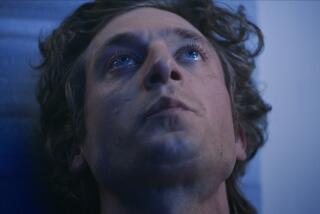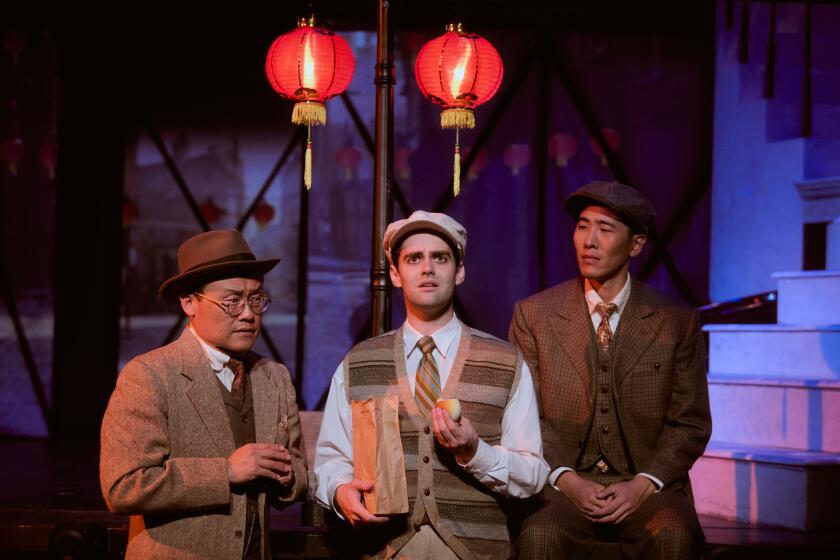Talk About a Worldview
What do you do after you’ve pulled off a surprisingly successful public event that pooled the resources of five Pasadena arts institutions? Organize an even bigger collaboration and add a scientific component.
That’s the impulse behind “The Universe: A Convergence of Art, Music and Science,” a multimedia exploration of the cosmos presented by eight cultural institutions in Pasadena and San Marino. Including exhibitions of art and science, films, concerts, lectures and workshops, the eclectic program surveys artists’ and scientists’ interpretations of the universe over 1,200 years.
Inevitably a bit unwieldy, the project couldn’t be perfectly coordinated. “Star Struck: One Thousand Years of the Art and Science of Astronomy,” a show of rare books, antique maps and celestial globes at the Huntington Library, Art Collections and Botanical Gardens, opened in December; “The Future of the Universe,” a science-fiction film festival at Caltech, began in January; “Music of the Spheres,” a series of concerts presented by Southwest Chamber Music at the Norton Simon Museum and the Colburn School of Performing Arts (in Los Angeles), started in September.
But most of the exhibitions open today. The lineup of new attractions:
* “Contemporary Art and the Cosmos,” a compilation of drawings, paintings, prints, photographs and sculptures by Dorothea Rockburne, Rockne Krebs, Vija Celmins, Robert Rauschenberg and other well-known artists, is at the Armory Center for the Arts.
* “Russell Crotty: The Universe From My Backyard,” an installation of drawings on paper-covered Lucite spheres--inspired by the night sky, as seen by the artist through a telescope mounted atop a shed in Malibu--is at Art Center College of Design.
* “Creation, Constellations and the Cosmos,” a comparison of Asian and European artists’ approach to the universe--including a huge (roughly 23-by-15-foot) Tibetan silk applique made in the late 18th century by the eighth Dalai Lama as a tribute to his teacher--is at the Norton Simon Museum.
* “Constructing the Cosmos in the Religious Arts of Asia,” an exploration of Hindu, Jain, Buddhist and Taoist perceptions of the universe in paintings, sculptures, textiles, ceramics and metalworks, is at the Pacific Asia Museum.
* “Contemporary Science and Popular Culture,” an outdoor exhibition of space photographs reproduced on mesh banners, and a Saturday series of educational programs offering opportunities to view the planets through telescopes, is at One Colorado, a commercial district in Old Pasadena.
*
The project began almost two years ago, at a celebratory breakfast for leaders of the previous collaboration, “Radical Past: Contemporary Art & Music in Pasadena, 1960-1974,” says Jay Belloli, who directs the Armory’s gallery programs and served as the sparkplug for both “Radical Past” and “The Universe.”
“We were all so pleased and amazed by the response to ‘Radical Past’ that we said, ‘What do we do next?’ A bunch of ideas were put forward, but nothing really caught our imaginations. Then Jeff von der Schmidt, artistic director of Southwest Chamber Music, asked about a space photography show that I wanted to do many years ago, and everybody’s eyes lit up. We started talking about the idea of the universe, and that was pretty much it.”
Von Der Schmidt was referring to a photographic history of the universe that Belloli had hoped to present in the late 1980s with Stephen Nowlin, gallery director at Art Center. But funding dried up when military and industrial companies that were expected to sponsor the show suffered an economic downturn. His exhibition subsequently appeared at India’s National Science Center in New Delhi, under the auspices of a joint U.S. and Indian sub-commission for education and culture, but it never came to Pasadena.
Belloli and Nowlin organized several other projects in the 1990s, however. Their association led the Armory and Art Center to join forces with the Norton Simon Museum, Southwest Chamber Music and One Colorado in 1999 to explore the golden age of the Pasadena Art Museum (now the Norton Simon Museum) in “Radical Past.” The current collaboration not only adds Caltech, the Huntington and the Pacific Asia Museum to the “Radical Past” roster, but also celebrates Pasadena’s importance in the field of science.
“Taking on ‘The Universe’ felt like turning from one part of Pasadena history to another, which involves Mt. Wilson Observatory, Caltech and Jet Propulsion Laboratory,” Belloli says. “It’s exciting to touch on that aspect of history.”
The project’s marriage of art and science is “an idiosyncratic Pasadena view of the universe,” Nowlin says. “I don’t think you would put these points of view together if you were doing it just anywhere, but that’s what is nice about it--that these institutions exist in this one community and that they work well together.”
Still, developing the components of the program was a challenge.
At Caltech, college representatives who were contacted about the collaboration initially had no idea what to do, says Robert A. Rosenstone, a professor of history, humanities and social sciences. “We don’t have an exhibition space. But Caltech is connected with the future of the universe--or we like to think we are--and JPL is sort of our sister institution, so we just cooked up an idea,” he says.
“Denise Nelson Nash does the programming for Beckman Auditorium, and I teach a course called the Science Fiction Film as History every two years. Between the two of us, we decided to show some of the science-fiction films from my class as a public event and bring in scientists and humanists for post-film discussion.”
Next up are “The Day the Earth Stood Still” (1951) on Feb. 13, and “Blade Runner” (1982) on Feb. 27. Both films will be screened at 7:30 p.m. in Baxter Lecture Hall.
The Huntington “sort of stumbled into the project” but quickly adapted and expanded an idea that was in the works, says Dan Lewis, a Huntington archivist and curator of American historical manuscripts. He and Ron Brashear, a curator at the Smithsonian Institution’s Dibner Library of the History of Science and Technology in Washington, organized a show that combines historic books and manuscripts with up-to-date banners and graphics, and computer stations that display CDs and videos.
Dramatically installed in the Boone Gallery, the exhibition offers works by many scientists, including Ptolemy, Galileo, Copernicus, Albert Einstein and Edwin Hubble, who developed the modern conception of the universe in the 1920s at Mt. Wilson Observatory.
While Lewis and Brashear rushed to develop the show and write the catalog, Simon Museum curators Michelle Deziel and Christine Knoke struggled to figure out an appropriate exhibition that could be drawn from the museum’s collections. The solution appeared when they realized that the museum may have few science-themed works, but its European and Asian holdings contain many spiritual interpretations of the universe.
What’s more, curators say, the show gave them a chance to organize the museum’s first exhibition of Eastern and Western artworks, displayed side by side for comparison. This is also the first time the galleries have displayed the monumental Tibetan applique. It was last seen by the public in 1979, when it was hung in the auditorium. No gallery wall is big enough to hold the piece, so it has been installed on a slanted, floor-to-ceiling board in the center of one gallery.
“It was a huge project,” Knoke says of the installation, “but it is spectacular.”
*
The Pacific Asia Museum’s show will complement the Simon’s exhibition with a comparative view of cosmic imagery from four religions as practiced in India, China, Tibet, Nepal and Japan. Among the wide range of Asian artworks are models of the universe constructed as demonstrations of religious devotion, and colorful portrayals of spiritual beliefs about the cosmos. In an 18th century Hindu painting of the creation of the world, gods and demons pull on a rope wrapped around a land mass to churn up other beings from an ocean of milk.
Science might seem to be almost completely divorced from the arts and religion, but they intersect in many interesting and provocative ways, “The Universe” organizers say. And Nowlin offers an example: NASA photographs, which were made as scientific documents, are not only appreciated as art, but also evoke spiritual feelings.
Leaders of the project hope their efforts will reach a broad audience, boosted by collective marketing and advertising and community buzz. Already, they are pleased with what they have accomplished.
“We didn’t agree all the time, but ‘Radical Past’ taught us how to do a collaboration,” Belloli says. “This one is much more complex, but we know much more what to do.”
Joining forces gave the group a louder voice than individual institutions have. That paid off in gaining the support of the city of Pasadena and in raising $150,000, Belloli says. Major donors include the California Council for the Humanities; the Ralph M. Parsons Foundation; Pasadena’s Cultural Affairs Division and its Arts Commission; and Victoria Solaini Baker, an artist, collector and longtime supporter of contemporary art programs in the city.
And even as the main shank of “The Universe” opens, there’s talk about the group’s next collaboration.
“We don’t have a theme yet,” Nowlin says, “but it’s not too soon to say we’ll have another one.”
*
More to Read
The biggest entertainment stories
Get our big stories about Hollywood, film, television, music, arts, culture and more right in your inbox as soon as they publish.
You may occasionally receive promotional content from the Los Angeles Times.






